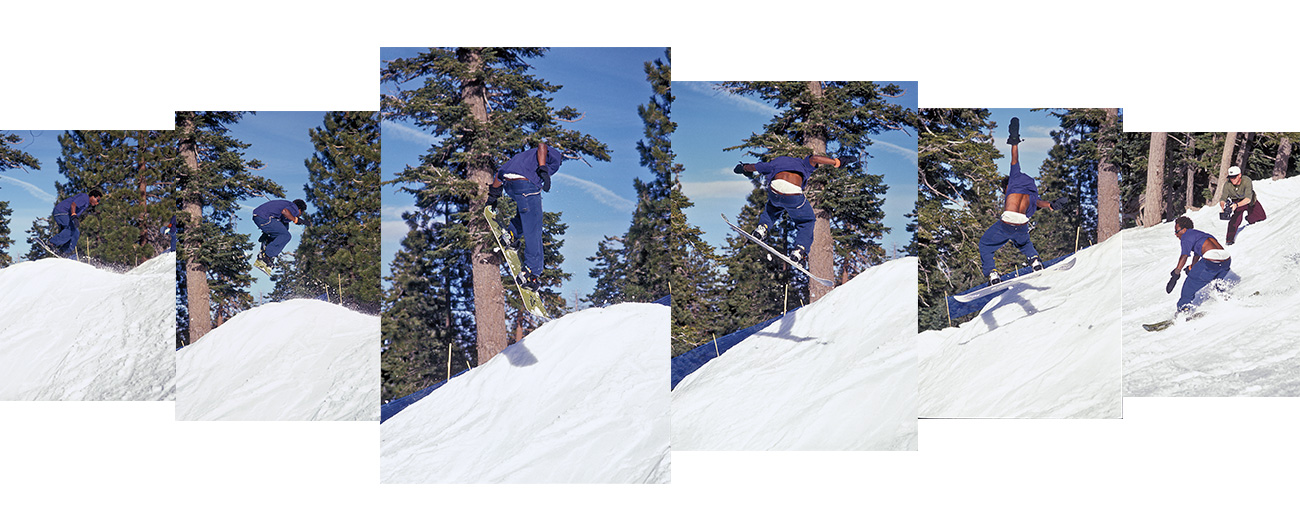Interview
Finding Fat Albert
Russell Winfield on Partying, Flat Kicks and the Stump of Manhood
This feature interview with Russell Winfield was first published in The Snowboarder’s Journal Issue 9.1.
Russell grew up in Upstate New York and had a passion for hockey—a vision to go big on skates. But after learning to ride, he hung up his skates and became the first black professional snowboarder. A thriving industry embraced him with open arms. He moved to the Rockies, became a leader of the jib movement and started filming with Whitey and then Mack Dawg Productions, Transworld and Standard Films. Take a quick peek at TB2 and see who is sitting in the car next to Terje and Daniel Franck screaming at the top of their lungs—yes, that would be Russ. He had interviews in Blunt and Heckler; he defined the industry with his comedy, individuality, love for the sport and love for the party life that came along with it.
Russell was a centerpiece of the upstart Ride Snowboards team, alongside Jake Blattner, Roan Rogers, Dale Rehberg and Jason Ford. You may remember his iconic Fat Albert pro model, but probably can’t find one because they sold out as fast as they were pressed. And then, as quickly as he came up, Russell was gone. During the late ‘90s, explains Russell, “the industry was changing and I was changing. I still wanted to do the punk-rock thing, the ‘I don’t give a f–k’ thing, and the industry just wasn’t there anymore.”
Now residing in the Seattle area, Russell lives a healthy life as a business entrepreneur, snowboarder, DJ, golfer and father. Times may have changed, but the mark Russell left during his half-decade at the top of the snowboard world is undeniable.
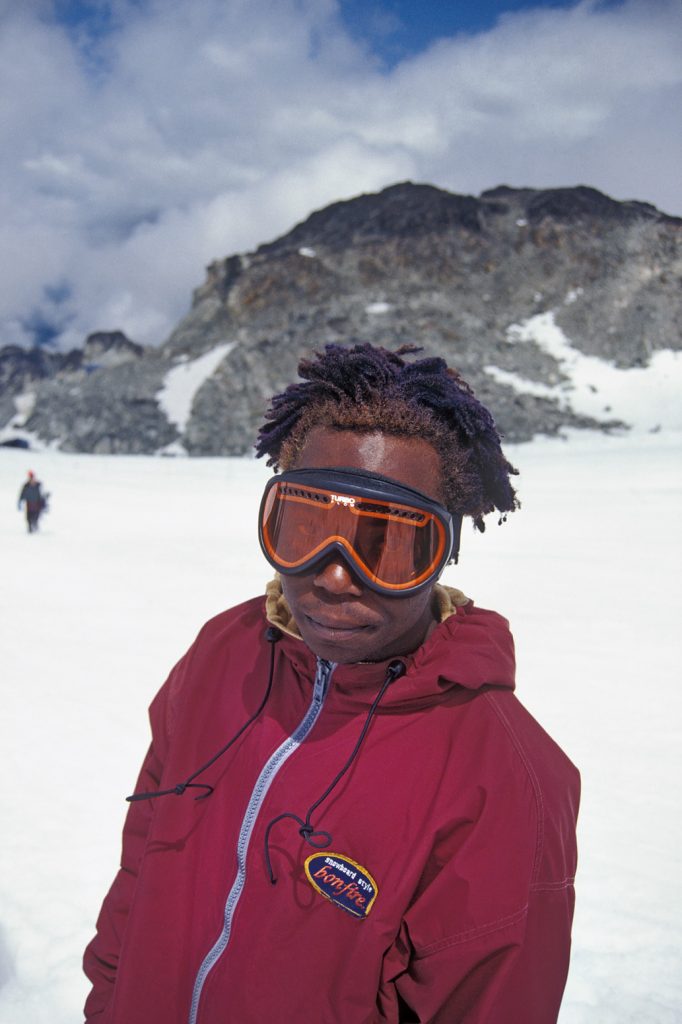
Winfield at summer camp on Blackcomb, BC, circa 1993. In 1996, Russell moved in with Devun Walsh in Vancouver for a spell, but had to leave when his mom passed away. Plus, “it got to be a pain in the ass to live in Canada illegally.” Photo: Dano Pendygrasse
JL: Tell me about growing up on the East Coast.
RW: I grew up in a bedroom community called Rye, New York. It’s about a 25-minute train ride outside of the city. Back then, snowboarding wasn’t really around. We played your normal jock sports, you know: football, hockey, lacrosse.
I ended up going to this school in Greenwich for hockey in the fifth grade. I went into a skate shop there and saw a Burton Performer Elite. I was like “Oh God. That is the shiiiiit.” So I got one and it was kind of an extension of a sled… like a downhill sled. There was this elevated tee box on a nearby golf course with a sand trap below it, and you could drop in off the tee box and ride into the sand trap. That got me super amped on snowboarding. I got pretty good at turning in the golf course powder; my snowboard had three fins on it, bro.
So I went up to Stratton and was like, “I got this,” but I couldn’t make a turn on the hard stuff. I didn’t get my certification, and I was super bitter. This chick, Susie Ruick, who was certifying me, was like, “You should probably take those fins off. It’s hard to make turns on the ice with fins.” So I took the fins off the next day and went back out and got it. There, I met up with all the old-school Stratton locals, like Doug and Tricia Byrnes, and became good friends with them. In those days, it was all about racing and half pipe; we didn’t have all the good snow and the big mountains. We just had little mole hills with ditches; in fact, the guy who dug the Stratton halfpipe had a summer job digging ditches.
There were two pipes at Stratton. They had this little mini ramp that looked like a drainage ditch in LA: flat-walled, with little kickers in it. One year they built an eight-foot pipe and we thought it was a superpipe. I remember dropping in for the first time, scared. We competed with the Stratton Mountain Allegro Team: Ross Powers, myself, Tricia Byrnes, Doug Byrnes, Matt Mitchell, Ryan Foley—just a bunch of East Coast kids. We would do Nationals every year. After the third year of doing that, I was like, “I am over this. This is stupid.” Susie Ruick ended up being one of our coaches; she was part of the OG Burton crew. I was telling her, “This racing stuff is for the birds. I just want to ride my freestyle board.” That was when I started riding for Burton; I went to Colorado for a photo shoot and never came back.
What did moving to Colorado do for your snowboarding?
It did everything. That was the hot spot, you know, going west. Every summer we would go to the Camp of Champions in Whistler. I met Dale Rehberg and Joe Wierzbinski there when I was 15. When I moved to Colorado, Dale was already there, so it was cool to get to hang out with those guys, and it was jib central. All we wanted to do was skateboard on our snowboards, and we were all about flat ollies to stuff, and over stuff, and going off kickers; we were trying to get as close to skateboarding as possible, right down to wearing jeans.
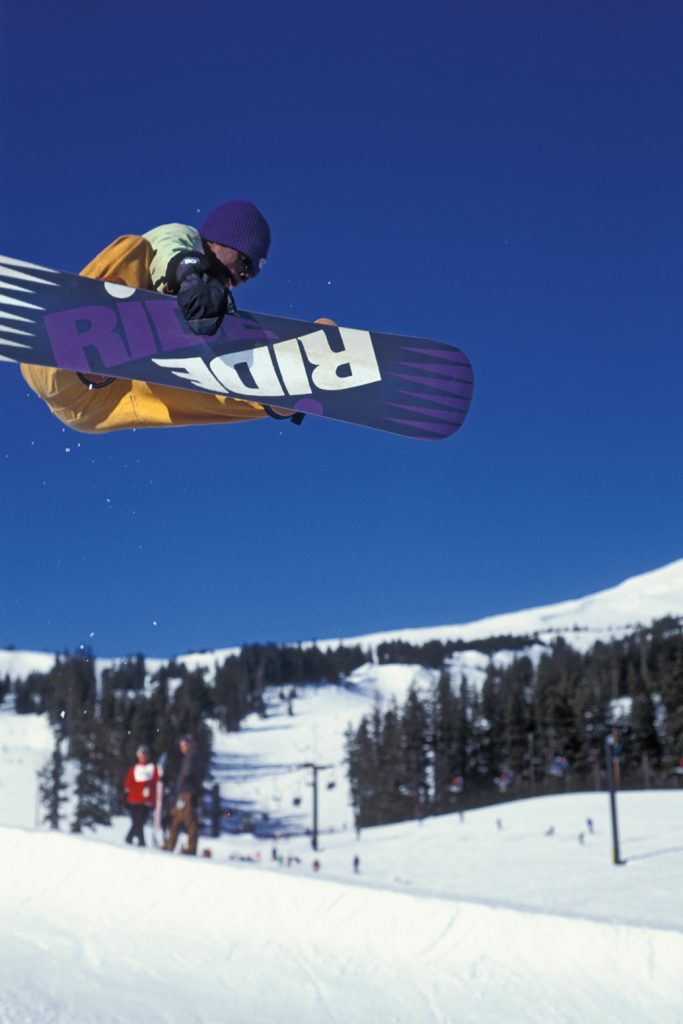
Although he was known for his skate-inspired freestyle, Russell could also hold is his own in the halfpipe. Frontside air at Mt Hood Meadows, OR, circa 1993. Photo: Dano Pendygrasse
Did you realize that you were progressing the sport?
You couldn’t ignore it—we were the polar opposite of everything out there. I remember being on a Burton shoot and we were flat ollieing this stump we called “the Stump of Manhood.” Everybody else was just making powder turns and hitting jumps. We were sliding handrails and going out at night and filming on wooden handrails. It was just completely different—we were the anti-contest snowboarders.
How was it to be the only black man in snowboarding?
Snowboarding itself was so new that being black wasn’t really the issue. People just hated snowboarding. It was easier because they didn’t have to hate me for being black, they could just hate me for being a snowboarder. As far as sponsorship goes, it absolutely helped.
When was the original Ride team assembled?
It was that next fall; in the summer of ’91, we all moved to San Diego. Tim Pogue, who was my Burton team manager, told me he was starting Ride. I was a little panicked, because he was so good to me with Burton. I have found in this industry that if there is someone so good to you, you want to stay by that person. He knew what we were all about and he was stoked on it; he knew our vision.
Tell me about the transition from Burton to the Ride team.
We weren’t that different—there was a whole movement waiting for something to happen. There were kids just waiting to buy stuff. Everything we did went directly back to skateboarding. All the shapes were flat-kicked, the graphics were a direct reflection of skateboards, but we knew it was snowboarding. We were very conscious of the historical significance; on the West Coast, there was a lot of skateboarding going on, but on the East Coast we were more focused on racing because of the influence of ski racing. Just like anything, you have kids who want to freestyle and kids who want to race. A big part of being on the Ride team was being punk-rock kids, kids who didn’t care, kids who would tell someone to “stick it wherever you want to stick it.” We were out to have fun and progress the sport in a way we saw fit.
So you had a pro model with Ride during the second year of the company?
Yeah, their first pro model was the RJ and it didn’t have the flat kicks. My pro model sold out fast. It was pretty gnarly; it became a collector’s item. It came in two graphics; since my graphic was Russell from Fat Albert, Bill Cosby’s group wasn’t too happy. They put a cease and desist on this, and so I had another graphic, which was the Yokohama Giant, a Japanese football team. We couldn’t sell that one in Japan because the Japanese distributor freaked out when he saw it. They sent all the Fat Albert boards to Japan and sold all the Yokohama Giant graphics here in the States.
Then you started working with Circus Distribution?
I was the original Dub rider, but we had all known Ken [Block] and Damon [Way] back in Breck. I had met Danny [Way] at a contest, and they used to hook us up with Eight Ball stuff. I have always had a good relationship with those guys. Then Cappel started, and at the same time Ken and Damon said, “Hey, we want to do a snow line, are you in?” And I was like, “Absolutely.” So I helped design outerwear and rode for them; it was super fun.
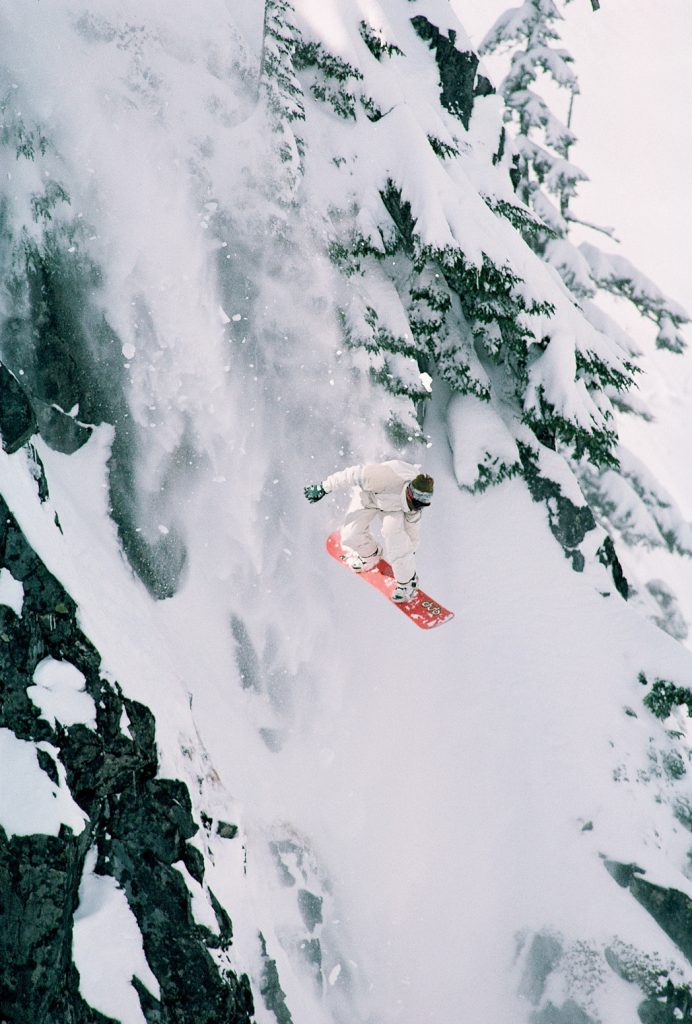
In the late ‘90s, Russell showed he could ride lines as well. Remembers photographer Sean Sullivan: “We were out with Dale Rehberg and Pat Abrahmson—Dale dropped it too but Russ got the plum line—and I think everyone was blown away. I’d never seen Russell do a cliff drop and he stomped it.” Photo: Sean Sullivan.
How much longer were you with the Ride program?
I was done with Ride in ’96; the industry was changing, I was changing. I still wanted to do the punk-rock thing, the “I don’t give a fuck” thing and the industry just wasn’t there.
Was there any bad blood there when you left?
A little. I was a punk kid and there were a bunch of egos involved. It has all been taken care of now.
You started your own golf company, right?
Me, Jack Coughlan and one of the other dudes from Ride, we had everything sampled out; everything from shoes and clothes down to the clubs. I personally think we did too much in the beginning, but I was just the creative director. I got to go to a trade show in Orlando. I was in the elevator with this guy and I was like, “Sweet, man, where did you get that Hugo Boss shirt?” He was like, “My girlfriend works for them,” or something like that. A few minutes later, I realized it was Phil Mickelson. That was my golf career highlight.
What has snowboarding done for you?
It has allowed me to see the entire world more than three times. It has taught me a lot about business and about growing up and the right way and wrong way to do it.
Any negatives?
Nothing that I didn’t do to myself. If you make a mistake and don’t learn from it, that’s bad; as long as you learn from it, it’s okay. Business is business and people are going to do what they do.
Did the lifestyle aspect catch up with you?
We didn’t really have to do many contests, so we would show up for a lot of demos. It was kinda like a 24-four-hour demo, honestly, that would go from the mountain, to the après, then to the bar or club or whatever and get sick with it, get wasted, hit on chicks. It was kind of a rock-star lifestyle, just traveling the whole world without much regard for anyone or anything, which is kinda bad, but, whatever, we were young.
When the party caught up with the snowboarding did it have any negative effects?
In my case, yes; which kinda sucks, ‘cause it ended the snowboarding for me. Partying elevates—it went from partying and snowboarding to going out [snowboardin] for a couple hours and partying for hours on end afterwards, then to not even going up and snowboarding. Ultimately, the party takes over.
Did you ever feel pressure to party as part of the job?
Absolutely, but I’m not gonna blame anybody for anything—I did it, nobody made me do it. I definitely think there was encouragement from others and I had a great time… most of the time. But did I end my career the way I wanted to? Did I do everything that I wanted to? No, not at all—but I did have a way better career than a lot of kids back then, and I can tell you that much.
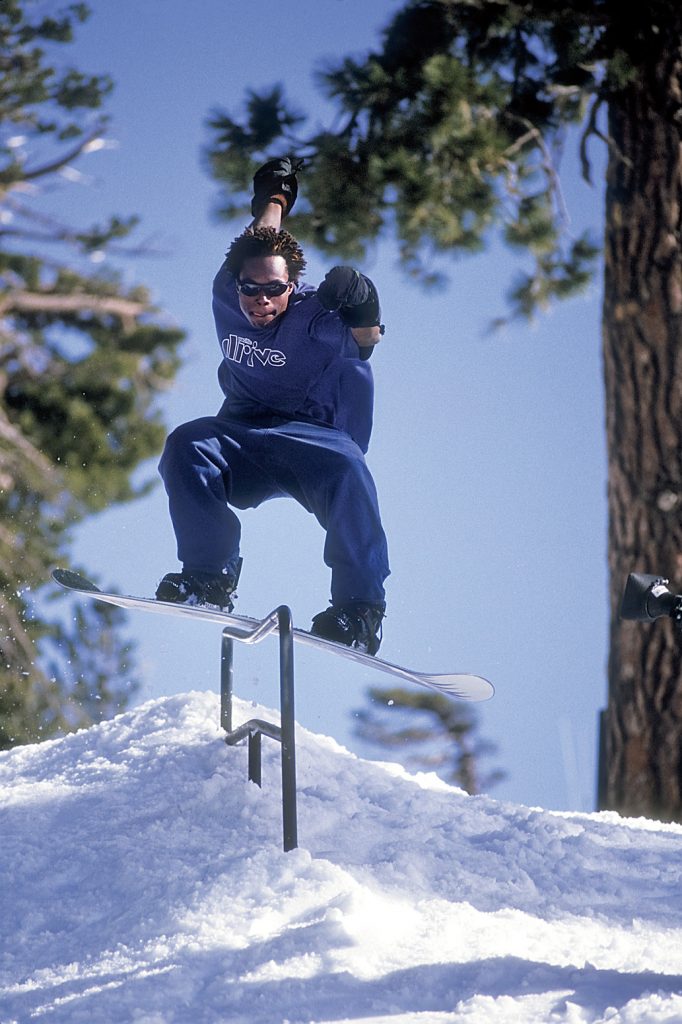
The epitome of skate-inspired riding at Snow Summit, CA, circa 1993. Says Russell: “All we wanted to do was skateboard on our snowboards… We were all about flat-ollieing to stuff, over stuff, kickers; we were trying to get as close to skateboarding as possible.” Photo: Dano Pendygrasse
Do you have any regrets?
Not really. Do I wish I did things differently? Absolutely, but I don’t think you can really regret too much.
Has there been a re-stoke in the last couple of years to get back out there?
Yeah, there has, actually. After snowboarding for 200-plus days a year, for way too many years, you kind of get burnt. You wake up and don’t know what country you are in and you are getting pulled in 14 different directions. Now, I do it for myself. I still have people who give me stuff and I am super thankful for that, but it is so fun to just get out there with the homies.
And you’re a father now?
Yeah, I got two little females running around. I have a 11-year-old Nikita and Safia, who’s two years old. Nikita has been snowboarding here and there, and Safia will be up there soon.
How has having children affected your life?
It’s different now than it was—I don’t live with them full time, but when they are around, it is amazing. You can’t really explain what it’s like to be a parent until you are a parent; you have unconditional love for your children and no matter how much they mess up, you always love them.
How do you feel about the new age of snowboarding?
The only problems I have with some of these new guys—and some of these guys have held out their hand to me—is that a lot of these kids don’t even know where snowboarding came from. That is like being black and not knowing about slavery or being Jewish and not knowing about the Holocaust. How do you not care where this came from and why you are able to do this? I am not saying it is because of me, by any means. I think you need to know the history of what you’re doing. There are a lot of kids out there in snowboarding making six figures, and they don’t even know who Jamie Lynn is… that is crazy to me. They need to open up the history books.
